Photo-Realistic Single Image Super-Resolution Using a Generative Adversarial
Network
Christian Ledig, Lucas Theis, Ferenc Husz´ar, Jose Caballero, Andrew Cunningham,
Alejandro Acosta, Andrew Aitken, Alykhan Tejani, Johannes Totz, Zehan Wang, Wenzhe Shi
Twitter
{cledig,ltheis,fhuszar,jcaballero,aacostadiaz,aaitken,atejani,jtotz,zehanw,wshi}@twitter.com
Abstract
1. Introduction
Despite the breakthroughs in accuracy and speed of
single image super-resolution using faster and deeper con-
volutional neural networks, one central problem remains
largely unsolved: how do we recover the finer texture details
when we super-resolve at large upscaling factors? The
behavior of optimization-based super-resolution methods is
principally driven by the choice of the objective function.
Recent work has largely focused on minimizing the mean
squared reconstruction error. The resulting estimates have
high peak signal-to-noise ratios, but they are often lacking
high-frequency details and are perceptually unsatisfying in
the sense that they fail to match the fidelity expected at
the higher resolution.
In this paper, we present SRGAN,
a generative adversarial network (GAN) for image super-
resolution (SR). To our knowledge, it is the first framework
capable of inferring photo-realistic natural images for 4×
upscaling factors. To achieve this, we propose a perceptual
loss function which consists of an adversarial loss and a
content loss. The adversarial loss pushes our solution to
the natural image manifold using a discriminator network
that is trained to differentiate between the super-resolved
images and original photo-realistic images. In addition, we
use a content loss motivated by perceptual similarity instead
of similarity in pixel space. Our deep residual network
is able to recover photo-realistic textures from heavily
downsampled images on public benchmarks. An extensive
mean-opinion-score (MOS) test shows hugely significant
gains in perceptual quality using SRGAN. The MOS scores
obtained with SRGAN are closer to those of the original
high-resolution images than to those obtained with any
state-of-the-art method.
The highly challenging task of estimating a high-
resolution (HR)
image from its low-resolution (LR)
counterpart is referred to as super-resolution (SR). SR
received substantial attention from within the computer
vision research community and has a wide range of
applications [62, 70, 42].
4× SRGAN (proposed)
original
Figure 1: Super-resolved image (left) is almost indistin-
guishable from original (right). [4× upscaling]
The ill-posed nature of the underdetermined SR problem
is particularly pronounced for high upscaling factors, for
which texture detail in the reconstructed SR images is
typically absent. The optimization target of supervised
SR algorithms is commonly the minimization of the mean
squared error (MSE) between the recovered HR image
and the ground truth. This is convenient as minimizing
MSE also maximizes the peak signal-to-noise ratio (PSNR),
which is a common measure used to evaluate and compare
SR algorithms [60]. However, the ability of MSE (and
PSNR) to capture perceptually relevant differences, such
as high texture detail, is very limited as they are defined
based on pixel-wise image differences [59, 57, 25]. This
is illustrated in Figure 2, where highest PSNR does not
necessarily reflect the perceptually better SR result. The
4681
�
bicubic
(21.59dB/0.6423)
SRResNet
(23.53dB/0.7832)
SRGAN
(21.15dB/0.6868)
original
Figure 2: From left to right: bicubic interpolation, deep residual network optimized for MSE, deep residual generative
adversarial network optimized for a loss more sensitive to human perception, original HR image. Corresponding PSNR and
SSIM are shown in brackets. [4× upscaling]
perceptual difference between the super-resolved and orig-
inal image means that the recovered image is not photo-
realistic as defined by Ferwerda [15].
In this work we propose a super-resolution generative
adversarial network (SRGAN) for which we employ a
deep residual network (ResNet) with skip-connection and
diverge from MSE as the sole optimization target. Different
from previous works, we define a novel perceptual loss us-
ing high-level feature maps of the VGG network [48, 32, 4]
combined with a discriminator that encourages solutions
perceptually hard to distinguish from the HR reference
images. An example photo-realistic image that was super-
resolved with a 4× upscaling factor is shown in Figure 1.
1.1. Related work
1.1.1
Image super-resolution
Recent overview articles on image SR include Nasrollahi
and Moeslund [42] or Yang et al. [60]. Here we will focus
on single image super-resolution (SISR) and will not further
discuss approaches that recover HR images from multiple
images [3, 14].
Prediction-based methods were among the first methods
to tackle SISR. While these filtering approaches, e.g. linear,
bicubic or Lanczos [13] filtering, can be very fast, they
oversimplify the SISR problem and usually yield solutions
with overly smooth textures. Methods that put particularly
focus on edge-preservation have been proposed [1, 38].
More powerful approaches aim to establish a complex
mapping between low- and high-resolution image informa-
tion and usually rely on training data. Many methods that
are based on example-pairs rely on LR training patches for
which the corresponding HR counterparts are known. Early
work was presented by Freeman et al. [17, 16]. Related ap-
proaches to the SR problem originate in compressed sensing
[61, 11, 68]. In Glasner et al. [20] the authors exploit patch
redundancies across scales within the image to drive the SR.
This paradigm of self-similarity is also employed in Huang
et al. [30], where self dictionaries are extended by further
allowing for small transformations and shape variations. Gu
et al. [24] proposed a convolutional sparse coding approach
that improves consistency by processing the whole image
rather than overlapping patches.
To reconstruct realistic texture detail while avoiding
edge artifacts, Tai et al. [51] combine an edge-directed SR
algorithm based on a gradient profile prior [49] with the
benefits of learning-based detail synthesis. Zhang et al. [69]
propose a multi-scale dictionary to capture redundancies of
similar image patches at different scales. To super-resolve
landmark images, Yue et al. [66] retrieve correlating HR
images with similar content from the web and propose a
structure-aware matching criterion for alignment.
Neighborhood embedding approaches upsample a LR
image patch by finding similar LR training patches in a low
dimensional manifold and combining their corresponding
HR patches for reconstruction [53, 54]. In Kim and Kwon
[34] the authors emphasize the tendency of neighborhood
approaches to overfit and formulate a more general map of
example pairs using kernel ridge regression. The regression
problem can also be solved with Gaussian process regres-
sion [26], trees [45] or Random Forests [46]. In Dai et al.
[5] a multitude of patch-specific regressors is learned and
the most appropriate regressors selected during testing.
Recently convolutional neural network (CNN) based SR
4682
�
In Wang
algorithms have shown excellent performance.
[58] the authors encode a sparse representation
et al.
prior into their feed-forward network architecture based on
the learned iterative shrinkage and thresholding algorithm
(LISTA) [22]. Dong et al. [8, 9] used bicubic interpolation
to upscale an input image and trained a three layer deep
fully convolutional network end-to-end to achieve state-
of-the-art SR performance. Subsequently, it was shown
that enabling the network to learn the upscaling filters
directly can further increase performance both in terms of
accuracy and speed [10, 47, 56]. With their deeply-recursive
convolutional network (DRCN), Kim et al. [33] presented
a highly performant architecture that allows for long-range
pixel dependencies while keeping the number of model
parameters small. Of particular relevance for our paper are
[4],
the works by Johnson et al.
who rely on a loss function closer to perceptual similarity
to recover visually more convincing HR images.
[32] and Bruna et al.
1.1.2 Design of convolutional neural networks
The state of the art for many computer vision problems is
meanwhile set by specifically designed CNN architectures
following the success of the work by Krizhevsky et al. [36].
It was shown that deeper network architectures can be
difficult to train but have the potential to substantially
increase the network’s accuracy as they allow modeling
mappings of very high complexity [48, 50].
To effi-
ciently train these deeper network architectures, batch-
normalization [31] is often used to counteract the internal
co-variate shift. Deeper network architectures have also
been shown to increase performance for SISR, e.g. Kim et
al. [33] formulate a recursive CNN and present state-of-the-
art results. Another powerful design choice that eases the
training of deep CNNs is the recently introduced concept of
residual blocks [28] and skip-connections [29, 33]. Skip-
connections relieve the network architecture of modeling
the identity mapping that is trivial in nature, however, po-
tentially non-trivial to represent with convolutional kernels.
In the context of SISR it was also shown that learning
upscaling filters is beneficial in terms of accuracy and speed
[10, 47, 56]. This is an improvement over Dong et al. [9]
where bicubic interpolation is employed to upscale the LR
observation before feeding the image to the CNN.
1.1.3 Loss functions
Pixel-wise loss functions such as MSE struggle to handle
the uncertainty inherent in recovering lost high-frequency
details such as texture: minimizing MSE encourages find-
ing pixel-wise averages of plausible solutions which are
typically overly-smooth and thus have poor perceptual qual-
ity [41, 32, 12, 4]. Reconstructions of varying perceptual
Figure 3:
Illustration of patches from the natural image
manifold (red) and super-resolved patches obtained with
MSE (blue) and GAN (orange). The MSE-based solution
appears overly smooth due to the pixel-wise average of
possible solutions in the pixel space, while GAN drives the
reconstruction towards the natural image manifold produc-
ing perceptually more convincing solutions.
quality are exemplified with corresponding PSNR in Fig-
ure 2. We illustrate the problem of minimizing MSE in Fig-
ure 3 where multiple potential solutions with high texture
details are averaged to create a smooth reconstruction.
In Mathieu et al. [41] and Denton et al. [6] the authors
tackled this problem by employing generative adversarial
networks (GANs) [21] for the application of image genera-
tion. Yu and Porikli [65] augment pixel-wise MSE loss with
a discriminator loss to train a network that super-resolves
face images with large upscaling factors (8×). GANs
were also used for unsupervised representation learning in
Radford et al.
[43]. The idea of using GANs to learn a
mapping from one manifold to another is described by Li
and Wand [37] for style transfer and Yeh et al.
[63] for
inpainting. Bruna et al. [4] minimize the squared error in
the feature spaces of VGG19 [48] and scattering networks.
Dosovitskiy and Brox [12] use loss functions based
on Euclidean distances computed in the feature space of
neural networks in combination with adversarial training.
It is shown that the proposed loss allows visually superior
image generation and can be used to solve the ill-posed
inverse problem of decoding nonlinear feature representa-
tions. Similar to this work, Johnson et al. [32] and Bruna
et al.
[4] propose the use of features extracted from a
pretrained VGG network instead of low-level pixel-wise
error measures. Specifically the authors formulate a loss
function based on the euclidean distance between feature
maps extracted from the VGG19 [48] network. Perceptually
more convincing results were obtained for both super-
resolution and artistic style-transfer [18, 19]. Recently, Li
and Wand [37] also investigated the effect of comparing and
4683
�
blending patches in pixel or VGG feature space.
1.2. Contribution
GANs provide a powerful framework for generating
plausible-looking natural images with high perceptual qual-
ity. The GAN procedure encourages the reconstructions
to move towards regions of the search space with high
probability of containing photo-realistic images and thus
closer to the natural image manifold as shown in Figure 3.
In this paper we describe the first very deep ResNet
[28, 29] architecture using the concept of GANs to form a
perceptual loss function for photo-realistic SISR. Our main
contributions are:
• We set a new state of the art for image SR with
high upscaling factors (4×) as measured by PSNR and
structural similarity (SSIM) with our 16 blocks deep
ResNet (SRResNet) optimized for MSE.
• We propose SRGAN which is a GAN-based network
optimized for a new perceptual loss. Here we replace
the MSE-based content loss with a loss calculated on
feature maps of the VGG network [48], which are
more invariant to changes in pixel space [37].
• We confirm with an extensive mean opinion score
(MOS) test on images from three public benchmark
datasets that SRGAN is the new state of the art, by a
large margin, for the estimation of photo-realistic SR
images with high upscaling factors (4×).
We describe the network architecture and the perceptual
loss in Section 2. A quantitative evaluation on public bench-
mark datasets as well as visual illustrations are provided in
Section 3. The paper concludes with a discussion in Section
4 and concluding remarks in Section 5.
2. Method
In SISR the aim is to estimate a high-resolution, super-
resolved image I SR from a low-resolution input image
I LR. Here I LR is the low-resolution version of its high-
resolution counterpart I HR. The high-resolution images
In training, I LR is
are only available during training.
obtained by applying a Gaussian filter to I HR followed by a
downsampling operation with downsampling factor r. For
an image with C color channels, we describe I LR by a
real-valued tensor of size W × H × C and I HR, I SR by
rW × rH × C respectively.
Our ultimate goal is to train a generating function G that
estimates for a given LR input image its corresponding HR
counterpart. To achieve this, we train a generator network as
a feed-forward CNN GθG parametrized by θG. Here θG =
{W1:L; b1:L} denotes the weights and biases of a L-layer
deep network and is obtained by optimizing a SR-specific
loss function lSR. For training images I HR
with corresponding I LR
, n = 1, . . . , N , we solve:
n
, n = 1, . . . , N
n
ˆθG = arg min
θG
1
N
N
X
n=1
lSR(GθG (I LR
n ), I HR
n )
(1)
In this work we will specifically design a perceptual loss
lSR as a weighted combination of several loss components
that model distinct desirable characteristics of the recovered
SR image. The individual loss functions are described in
more detail in Section 2.2.
2.1. Adversarial network architecture
Following Goodfellow et al.
[21] we further define
a discriminator network DθD which we optimize in an
alternating manner along with GθG to solve the adversarial
min-max problem:
min
θG
max
θD
E
IHR∼ptrain(IHR)[log DθD (I HR)]+
E
I LR∼pG(I LR)[log(1 − DθD (GθG(I LR))]
(2)
The general idea behind this formulation is that it allows
one to train a generative model G with the goal of fooling a
differentiable discriminator D that is trained to distinguish
super-resolved images from real images. With this approach
our generator can learn to create solutions that are highly
similar to real images and thus difficult to classify by D.
This encourages perceptually superior solutions residing in
the subspace, the manifold, of natural images. This is in
contrast to SR solutions obtained by minimizing pixel-wise
error measurements, such as the MSE.
At the core of our very deep generator network G, which
is illustrated in Figure 4 are B residual blocks with identical
layout. Inspired by Johnson et al. [32] we employ the block
layout proposed by Gross and Wilber [23]. Specifically, we
use two convolutional layers with small 3×3 kernels and 64
feature maps followed by batch-normalization layers [31]
and ParametricReLU [27] as the activation function. We
increase the resolution of the input image with two trained
sub-pixel convolution layers as proposed by Shi et al. [47].
To discriminate real HR images from generated SR
samples we train a discriminator network. The architecture
is shown in Figure 4. We follow the architectural guidelines
[43] and use LeakyReLU
summarized by Radford et al.
activation (α = 0.2) and avoid max-pooling throughout
the network. The discriminator network is trained to solve
the maximization problem in Equation 2. It contains eight
convolutional layers with an increasing number of 3 × 3
filter kernels, increasing by a factor of 2 from 64 to 512 ker-
nels as in the VGG network [48]. Strided convolutions are
used to reduce the image resolution each time the number
of features is doubled. The resulting 512 feature maps are
followed by two dense layers and a final sigmoid activation
4684
�
Figure 4: Architecture of Generator and Discriminator Network with corresponding kernel size (k), number of feature maps
(n) and stride (s) indicated for each convolutional layer.
function to obtain a probability for sample classification.
2.2. Perceptual loss function
The definition of our perceptual loss function lSR is crit-
ical for the performance of our generator network. While
lSR is commonly modeled based on the MSE [9, 47], we
improve on Johnson et al. [32] and Bruna et al. [4] and
design a loss function that assesses a solution with respect
to perceptually relevant characteristics. We formulate the
perceptual loss as the weighted sum of a content loss (lSR
X )
and an adversarial loss component as:
lSR =
lSR
X
|{z}
|
content loss
adversarial loss
+ 10−3lSR
Gen
}
}
|
{z
{z
perceptual loss (for VGG based content losses)
(3)
In the following we describe possible choices for the con-
tent loss lSR
X and the adversarial loss lSR
Gen.
2.2.1 Content loss
The pixel-wise MSE loss is calculated as:
This is the most widely used optimization target for im-
age SR on which many state-of-the-art approaches rely
[9, 47]. However, while achieving particularly high PSNR,
solutions of MSE optimization problems often lack high-
frequency content which results in perceptually unsatisfy-
ing solutions with overly smooth textures (c.f . Figure 2).
Instead of relying on pixel-wise losses we build on the
ideas of Gatys et al. [18], Bruna et al. [4] and Johnson et
al. [32] and use a loss function that is closer to perceptual
similarity. We define the VGG loss based on the ReLU
activation layers of the pre-trained 19 layer VGG network
described in Simonyan and Zisserman [48]. With φi,j we
indicate the feature map obtained by the j-th convolution
(after activation) before the i-th maxpooling layer within the
VGG19 network, which we consider given. We then define
the VGG loss as the euclidean distance between the feature
representations of a reconstructed image GθG (I LR) and the
reference image I HR:
lSR
V GG/i.j =
1
Wi,jHi,j
Wi,j
X
Hi,j
X
(φi,j(I HR)x,y
y=1
x=1
− φi,j(GθG (I LR))x,y)2
(5)
lSR
M SE =
1
r2W H
rW
X
rH
X
x=1
y=1
(I HR
x,y − GθG (I LR)x,y)2
(4)
Here Wi,j and Hi,j describe the dimensions of the
respective feature maps within the VGG network.
4685
�
2.2.2 Adversarial loss
In addition to the content losses described so far, we also
add the generative component of our GAN to the perceptual
loss. This encourages our network to favor solutions that
reside on the manifold of natural images, by trying to
fool the discriminator network. The generative loss lSR
Gen
is defined based on the probabilities of the discriminator
DθD (GθG (I LR)) over all training samples as:
lSR
Gen =
N
X
n=1
− log DθD (GθG(I LR))
(6)
Here, DθD (GθG (I LR)) is the probability that the recon-
structed image GθG (I LR) is a natural HR image. For better
gradient behavior we minimize − log DθD (GθG (I LR)) in-
stead of log[1 − DθD (GθG(I LR))] [21].
3. Experiments
3.1. Data and similarity measures
We perform experiments on three widely used bench-
mark datasets Set5 [2], Set14 [68] and BSD100, the testing
set of BSD300 [40]. All experiments are performed with
a scale factor of 4× between low- and high-resolution
images. This corresponds to a 16× reduction in image
pixels. For fair comparison, all reported PSNR [dB] and
SSIM [57] measures were calculated on the y-channel of
center-cropped, removal of a 4-pixel wide strip from each
border, images using the daala package1. Super-resolved
images for the reference methods, including nearest neigh-
bor, bicubic, SRCNN [8] and SelfExSR [30], were obtained
from online material supplementary to Huang et al.2 [30]
and for DRCN from Kim et al.3
[33]. Results obtained
with SRResNet (for losses: lSR
V GG/2.2) and the
SRGAN variants are available online4. Statistical tests were
performed as paired two-sided Wilcoxon signed-rank tests
and significance determined at p < 0.05.
M SE and lSR
The reader may also be interested in an independently
developed GAN-based solution on GitHub5. However it
only provides experimental results on a limited set of faces,
which is a more constrained and easier task.
3.2. Training details and parameters
We trained all networks on a NVIDIA Tesla M40 GPU
using a random sample of 350 thousand images from the
ImageNet database [44]. These images are distinct from the
1https://github.com/xiph/daala (commit: 8d03668)
2https://github.com/jbhuang0604/SelfExSR
3http://cv.snu.ac.kr/research/DRCN/
4https://twitter.box.com/s/
lcue6vlrd01ljkdtdkhmfvk7vtjhetog
5https://github.com/david-gpu/srez
testing images. We obtained the LR images by downsam-
pling the HR images (BGR, C = 3) using bicubic kernel
with downsampling factor r = 4. For each mini-batch we
crop 16 random 96 × 96 HR sub images of distinct training
images. Note that we can apply the generator model to
images of arbitrary size as it is fully convolutional. For
optimization we use Adam [35] with β1 = 0.9. The SRRes-
Net networks were trained with a learning rate of 10−4 and
106 update iterations. We employed the trained MSE-based
SRResNet network as initialization for the generator when
training the actual GAN to avoid undesired local optima.
All SRGAN variants were trained with 105 update iterations
at a learning rate of 10−4 and another 105 iterations at a
lower rate of 10−5. We alternate updates to the generator
and discriminator network, which is equivalent to k = 1
as used in Goodfellow et al. [21]. Our generator network
has 16 identical (B = 16) residual blocks. During test time
we turn batch-normalization update off to obtain an output
that deterministically depends only on the input [31]. Our
implementation is based on Theano [52] and Lasagne [7].
3.3. Mean opinion score (MOS) testing
We have performed a MOS test to quantify the ability of
different approaches to reconstruct perceptually convincing
images. Specifically, we asked 26 raters to assign an inte-
gral score from 1 (bad quality) to 5 (excellent quality) to the
super-resolved images. The raters rated 12 versions of each
image on Set5, Set14 and BSD100: nearest neighbor (NN),
bicubic, SRCNN [8], SelfExSR [30], DRCN [33], ESPCN
[47], SRResNet-MSE, SRResNet-VGG22∗ (∗not rated on
BSD100), SRGAN-MSE∗, SRGAN-VGG22∗, SRGAN-
VGG54 and the original HR image. Each rater thus rated
1128 instances (12 versions of 19 images plus 9 versions of
100 images) that were presented in a randomized fashion.
The raters were calibrated on the NN (score 1) and HR (5)
versions of 20 images from the BSD300 training set. In a
pilot study we assessed the calibration procedure and the
test-retest reliability of 26 raters on a subset of 10 images
from BSD100 by adding a method’s images twice to a
larger test set. We found good reliability and no significant
differences between the ratings of the identical images.
Raters very consistently rated NN interpolated test images
as 1 and the original HR images as 5 (c.f . Figure 5).
The experimental results of the conducted MOS tests are
summarized in Table 1, Table 2 and Figure 5.
3.4. Investigation of content loss
We investigated the effect of different content
loss
choices in the perceptual loss for the GAN-based networks.
Specifically we investigate lSR = lSR
Gen for the
following content losses lSR
X :
X + 10−3lSR
• SRGAN-MSE: lSR
M SE, to investigate the adversarial
network with the standard MSE as content loss.
4686
�
Table 1: Performance of different loss functions for SR-
ResNet and the adversarial networks on Set5 and Set14
benchmark data. MOS score significantly higher (p < 0.05)
than with other losses in that category∗. [4× upscaling]
SRResNet-
Set5
MSE
PSNR 32.05
SSIM 0.9019
MOS
3.37
VGG22 MSE
30.64
30.51
0.8701
0.8803
3.46
3.77
SRGAN-
VGG22 VGG54
29.84
0.8468
3.78
29.40
0.8472
3.58
Set14
PSNR 28.49
SSIM 0.8184
MOS
2.98
27.19
0.7807
3.15∗
26.92
0.7611
3.43
26.44
0.7518
3.57
26.02
0.7397
3.72∗
• SRGAN-VGG22: lSR
V GG/2.2 with φ2,2, a loss defined
on feature maps representing lower-level features [67].
• SRGAN-VGG54: lSR
V GG/5.4 with φ5,4, a loss defined
on feature maps of higher level features from deeper
network layers with more potential to focus on the
content of the images [67, 64, 39]. We refer to this
network as SRGAN in the following.
We also evaluate the performance of the generator network
without adversarial component for the two losses lSR
M SE
(SRResNet-MSE) and lSR
V GG/2.2 (SRResNet-VGG22). We
refer to SRResNet-MSE as SRResNet. Quantitative results
are summarized in Table 1 and visual examples provided in
Figure 6. Even combined with the adversarial loss, MSE
provides solutions with the highest PSNR values that are,
however, perceptually rather smooth and less convincing
than results achieved with a loss component more sensitive
to visual perception. This is caused by competition be-
tween the MSE-based content loss and the adversarial loss.
We further attribute minor reconstruction artifacts, which
we observed in a minority of SRGAN-MSE-based recon-
structions, to those competing objectives. We could not
determine a significantly best loss function for SRResNet
or SRGAN with respect to MOS score on Set5. However,
SRGAN-VGG54 significantly outperformed other SRGAN
and SRResNet variants on Set14 in terms of MOS. We
observed a trend that using the higher level VGG feature
maps φ5,4 yields better texture detail when compared to
φ2,2 (c.f . Figure 6).
3.5. Performance of the final networks
We compare the performance of SRResNet and SR-
GAN to NN, bicubic interpolation, and four state-of-the-
art methods. Quantitative results are summarized in Table
2 and confirm that SRResNet (in terms of PSNR/SSIM)
sets a new state of the art on three benchmark datasets.
Please note that we used a publicly available framework
Figure 5: Color-coded distribution of MOS scores on
BSD100. For each method 2600 samples (100 images ×
26 raters) were assessed. Mean shown as red marker, where
the bins are centered around value i. [4× upscaling]
for evaluation (c.f . Section 3.1), reported values might thus
slightly deviate from those reported in the original papers.
We further obtained MOS ratings for SRGAN and all
reference methods on BSD100. The results shown in Table
2 confirm that SRGAN outperforms all reference methods
by a large margin and sets a new state of the art for photo-
realistic image SR. All differences in MOS (c.f . Table
2) are highly significant on BSD100, except SRCNN vs.
SelfExSR. The distribution of all collected MOS ratings is
summarized in Figure 5.
4. Discussion and future work
We confirmed the superior perceptual performance of
SRGAN using MOS testing. We have further shown that
standard quantitative measures such as PSNR and SSIM
fail to capture and accurately assess image quality with
respect to the human visual system [55]. The focus of this
work was the perceptual quality of super-resolved images
rather than computational efficiency. The presented model
[47], not optimized for video
is, in contrast to Shi et al.
SR in real-time. However, preliminary experiments on the
network architecture suggest that shallower networks have
the potential to provide very efficient alternatives at a small
reduction of qualitative performance. In contrast to Dong et
al. [9], we found deeper network architectures to be benefi-
cial. We speculate that the ResNet design has a substantial
impact on the performance of deeper networks. We found
that even deeper networks (B > 16) can further increase
the performance of SRResNet, however, come at the cost
of longer training and testing times. We found SRGAN
variants of deeper networks are increasingly difficult to train
due to the appearance of high-frequency artifacts.
Of particular importance when aiming for photo-realistic
solutions to the SR problem is the choice of the content loss
as illustrated in Figure 6. In this work, we found lSR
V GG/5.4
to yield the perceptually most convincing results, which
we attribute to the potential of deeper network layers to
represent features of higher abstraction [67, 64, 39] away
4687
�
SRResNet
SRGAN-MSE
SRGAN-VGG22
SRGAN-VGG54
original HR image
(a)
(c)
(e)
(g)
(i)
(b)
(d)
(f)
(h)
(j)
Figure 6: SRResNet (left: a,b), SRGAN-MSE (middle left: c,d), SRGAN-VGG2.2 (middle: e,f) and SRGAN-VGG54
(middle right: g,h) reconstruction results and corresponding reference HR image (right: i,j). [4× upscaling]
Table 2: Comparison of NN, bicubic, SRCNN [8], SelfExSR [30], DRCN [33], ESPCN [47], SRResNet, SRGAN-VGG54
and the original HR on benchmark data. Highest measures (PSNR [dB], SSIM, MOS) in bold. [4× upscaling]
Set5
PSNR
SSIM
MOS
Set14
PSNR
SSIM
MOS
BSD100
PSNR
SSIM
MOS
nearest
26.26
0.7552
1.28
bicubic
28.43
0.8211
1.97
SRCNN SelfExSR DRCN ESPCN SRResNet
30.07
0.8627
2.57
32.05
0.9019
3.37
30.33
0.872
2.65
31.52
0.8938
3.26
30.76
0.8784
2.89
24.64
0.7100
1.20
25.99
0.7486
1.80
27.18
0.7861
2.26
27.45
0.7972
2.34
28.02
0.8074
2.84
27.66
0.8004
2.52
28.49
0.8184
2.98
25.02
0.6606
1.11
25.94
0.6935
1.47
26.68
0.7291
1.87
26.83
0.7387
1.89
27.21
0.7493
2.12
27.02
0.7442
2.01
27.58
0.7620
2.29
SRGAN HR
∞
29.40
1
0.8472
3.58
4.32
26.02
0.7397
3.72
25.16
0.6688
3.56
∞
1
4.32
∞
1
4.46
from pixel space. We speculate that feature maps of these
deeper layers focus purely on the content while leaving the
adversarial loss focusing on texture details which are the
main difference between the super-resolved images without
the adversarial loss and photo-realistic images. We also
note that the ideal loss function depends on the application.
For example, approaches that hallucinate finer detail might
be less suited for medical applications or surveillance. The
perceptually convincing reconstruction of text or structured
scenes [30] is challenging and part of future work. The
development of content loss functions that describe image
spatial content, but more invariant to changes in pixel space
will further improve photo-realistic image SR results.
5. Conclusion
We have described a deep residual network SRRes-
Net that sets a new state of the art on public benchmark
datasets when evaluated with the widely used PSNR mea-
sure. We have highlighted some limitations of this PSNR-
focused image super-resolution and introduced SRGAN,
which augments the content loss function with an adversar-
ial loss by training a GAN. Using extensive MOS testing,
we have confirmed that SRGAN reconstructions for large
upscaling factors (4×) are, by a considerable margin, more
photo-realistic than reconstructions obtained with state-of-
the-art reference methods.
4688
�
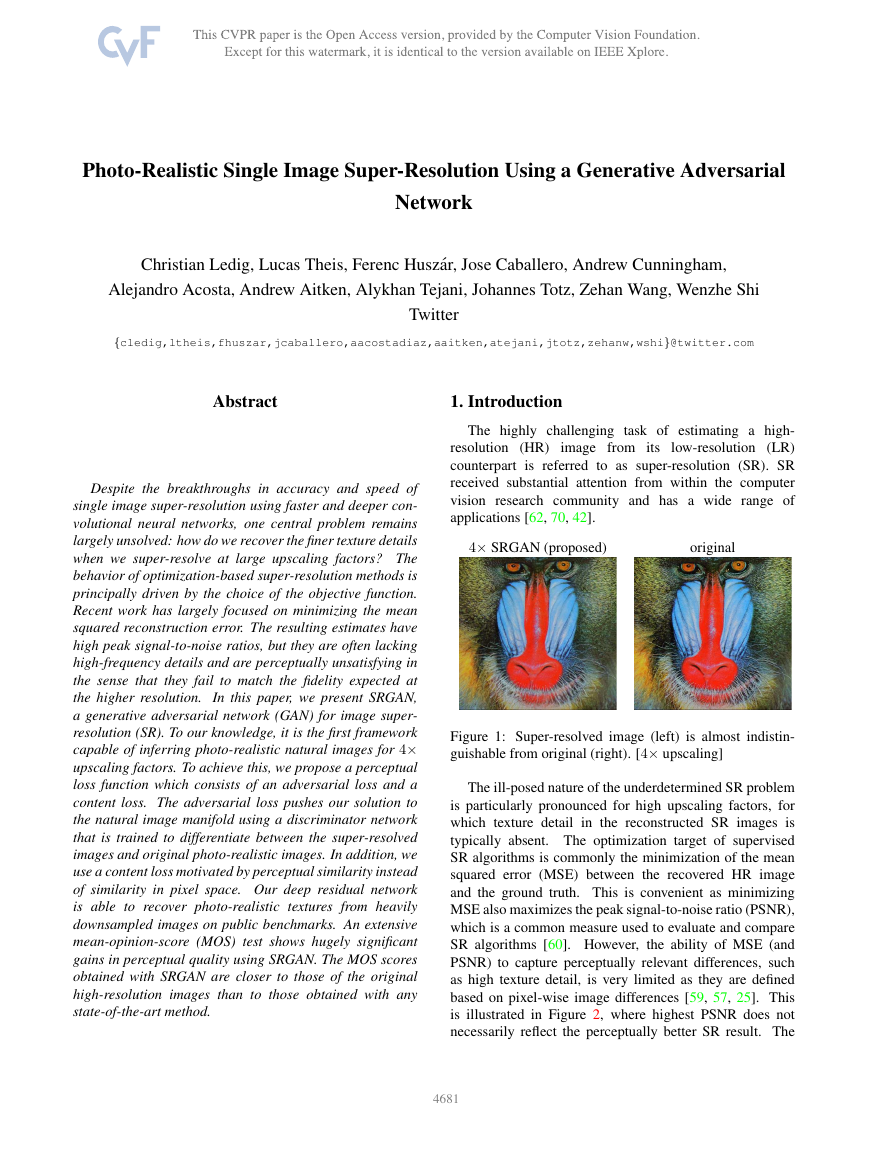
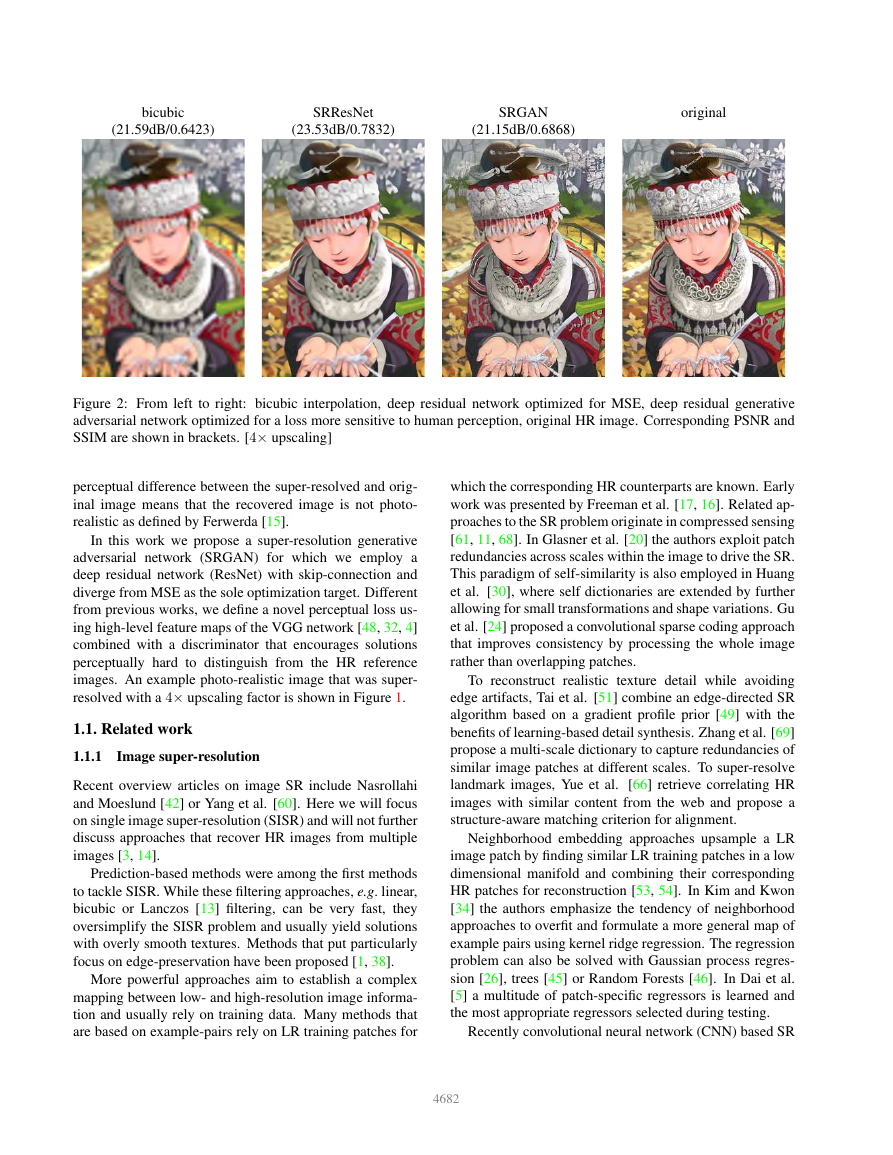
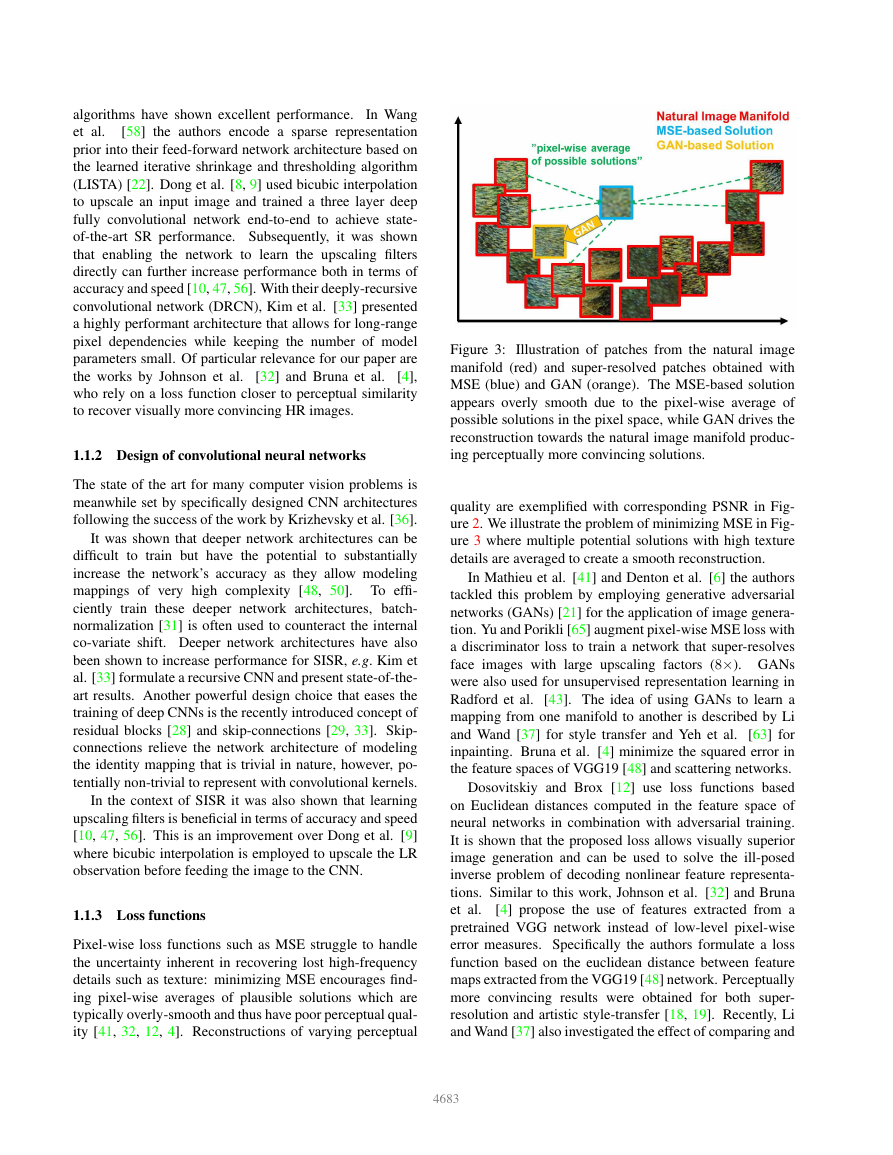
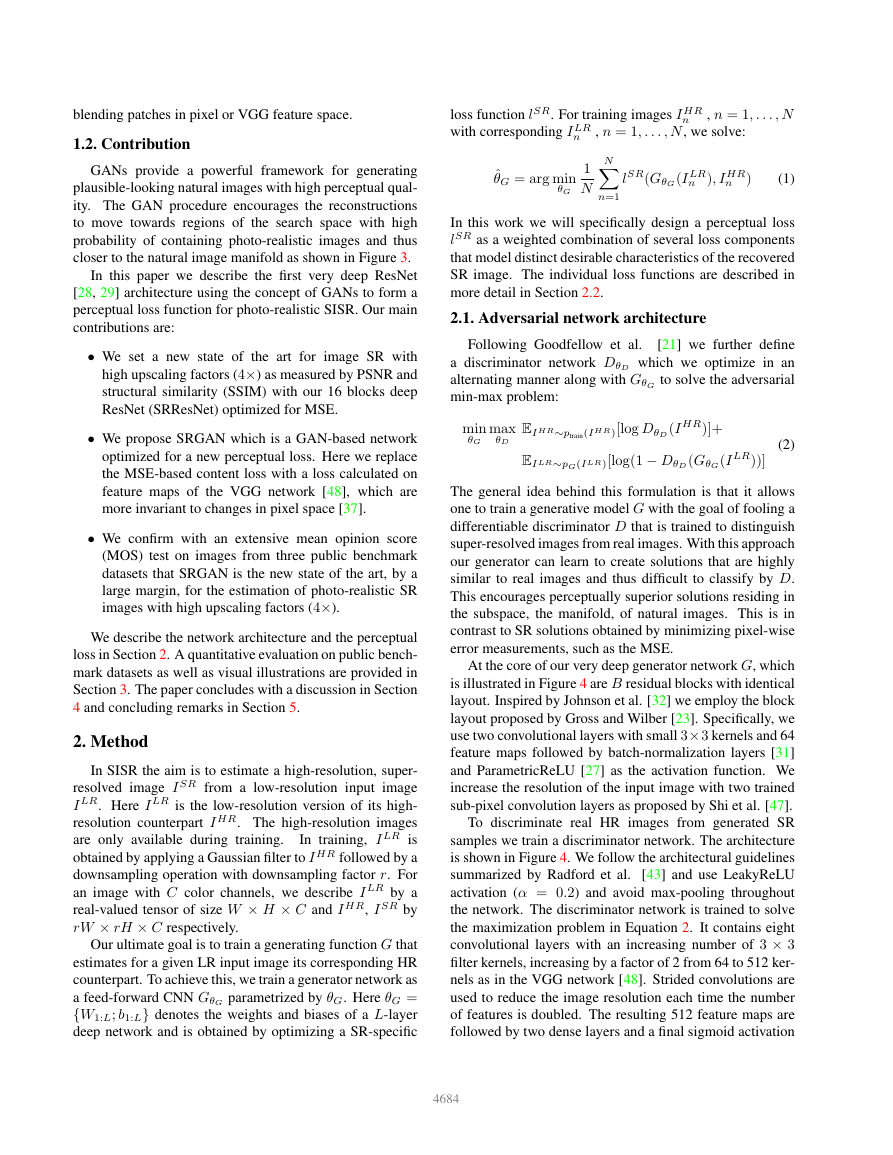
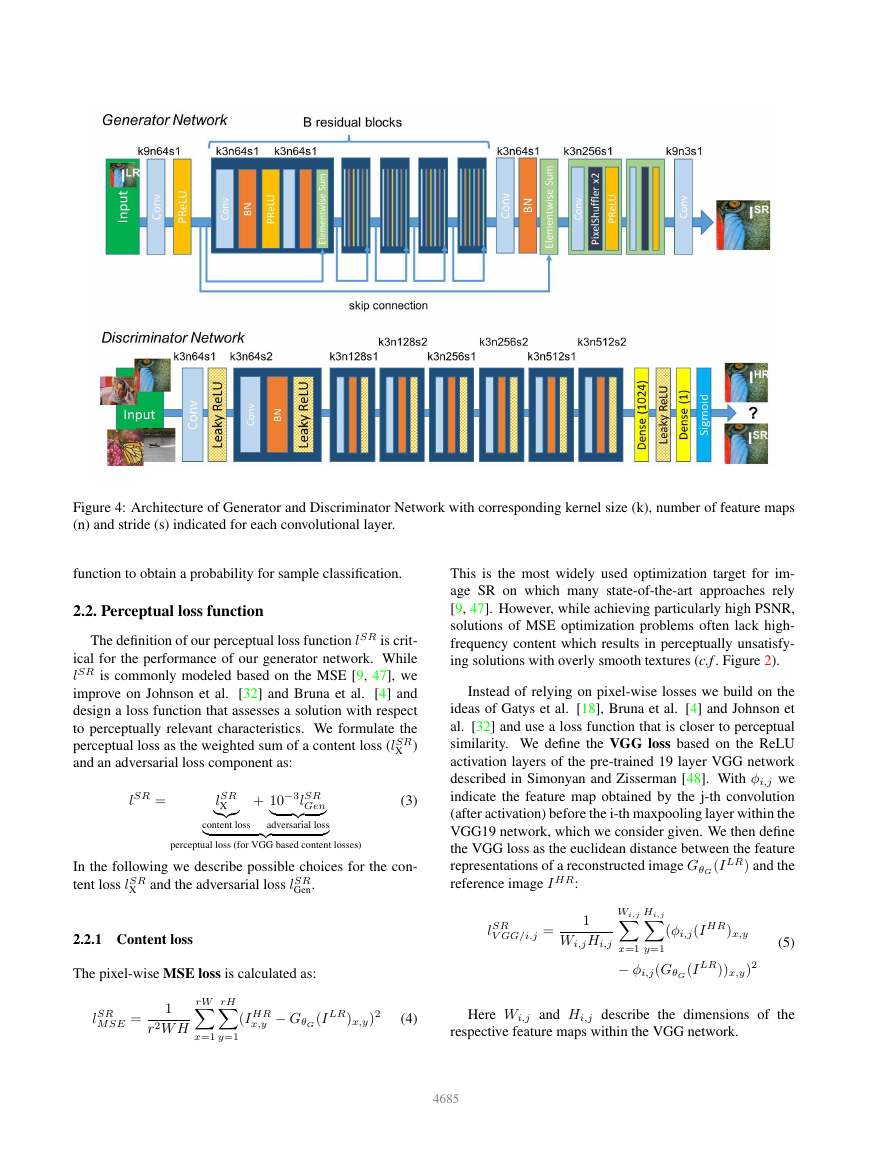
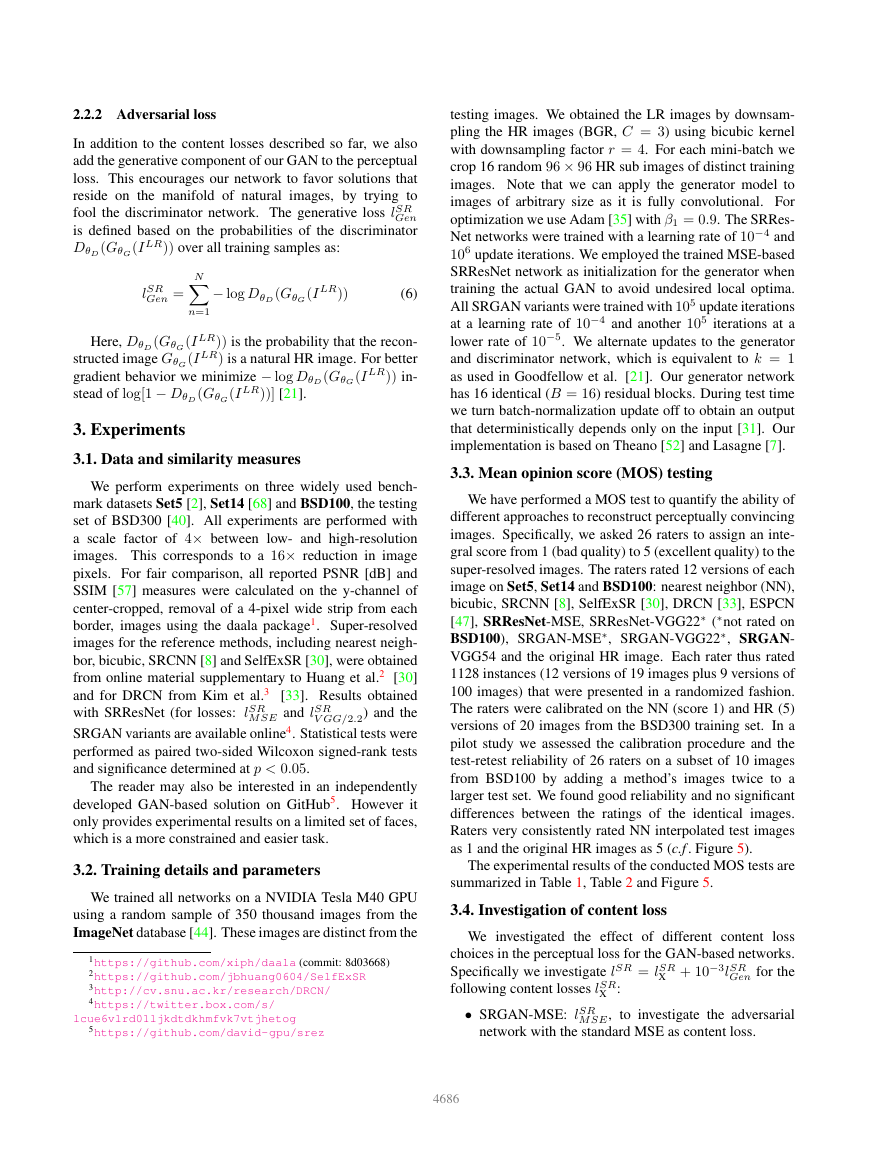










 2023年江西萍乡中考道德与法治真题及答案.doc
2023年江西萍乡中考道德与法治真题及答案.doc 2012年重庆南川中考生物真题及答案.doc
2012年重庆南川中考生物真题及答案.doc 2013年江西师范大学地理学综合及文艺理论基础考研真题.doc
2013年江西师范大学地理学综合及文艺理论基础考研真题.doc 2020年四川甘孜小升初语文真题及答案I卷.doc
2020年四川甘孜小升初语文真题及答案I卷.doc 2020年注册岩土工程师专业基础考试真题及答案.doc
2020年注册岩土工程师专业基础考试真题及答案.doc 2023-2024学年福建省厦门市九年级上学期数学月考试题及答案.doc
2023-2024学年福建省厦门市九年级上学期数学月考试题及答案.doc 2021-2022学年辽宁省沈阳市大东区九年级上学期语文期末试题及答案.doc
2021-2022学年辽宁省沈阳市大东区九年级上学期语文期末试题及答案.doc 2022-2023学年北京东城区初三第一学期物理期末试卷及答案.doc
2022-2023学年北京东城区初三第一学期物理期末试卷及答案.doc 2018上半年江西教师资格初中地理学科知识与教学能力真题及答案.doc
2018上半年江西教师资格初中地理学科知识与教学能力真题及答案.doc 2012年河北国家公务员申论考试真题及答案-省级.doc
2012年河北国家公务员申论考试真题及答案-省级.doc 2020-2021学年江苏省扬州市江都区邵樊片九年级上学期数学第一次质量检测试题及答案.doc
2020-2021学年江苏省扬州市江都区邵樊片九年级上学期数学第一次质量检测试题及答案.doc 2022下半年黑龙江教师资格证中学综合素质真题及答案.doc
2022下半年黑龙江教师资格证中学综合素质真题及答案.doc